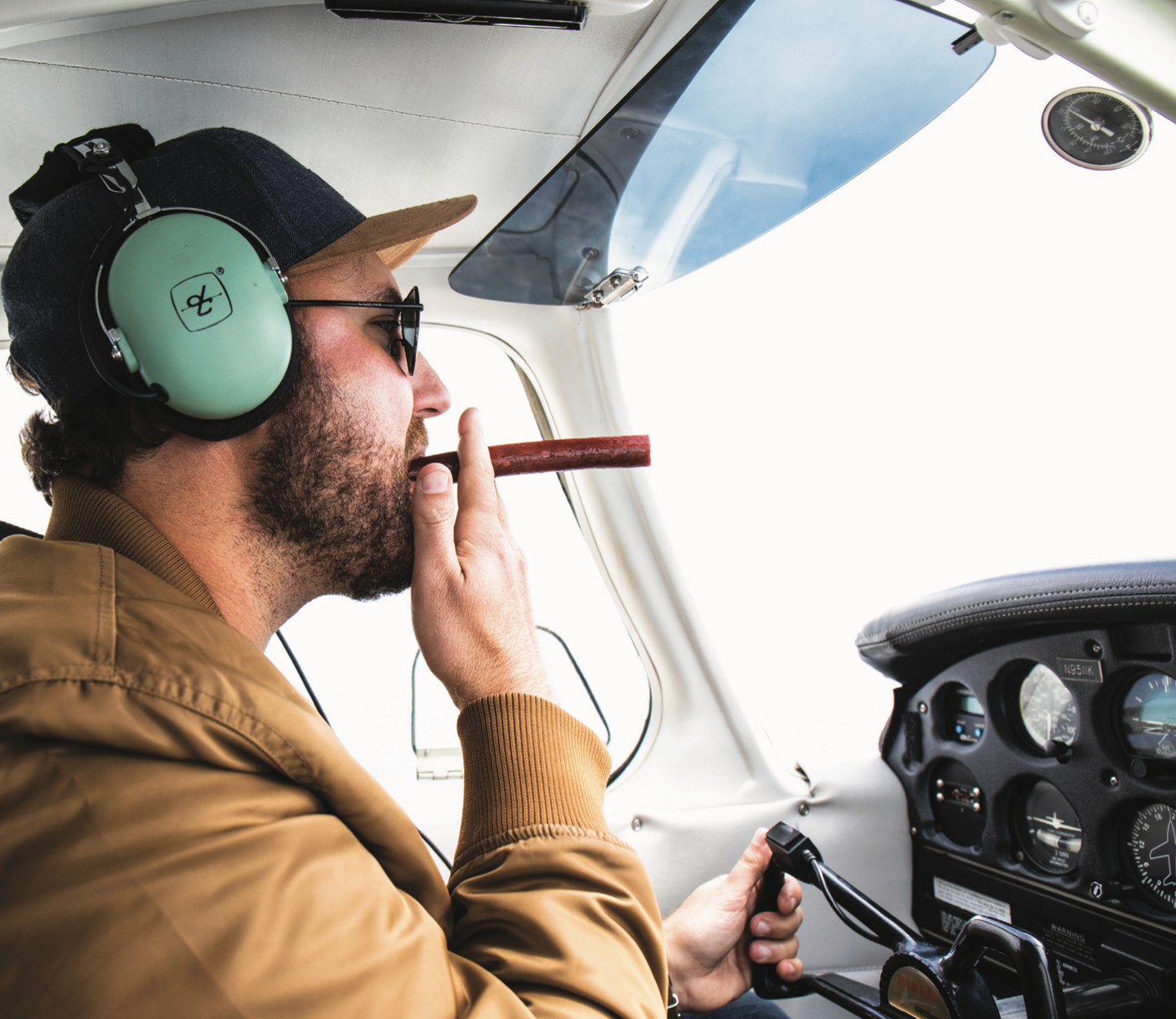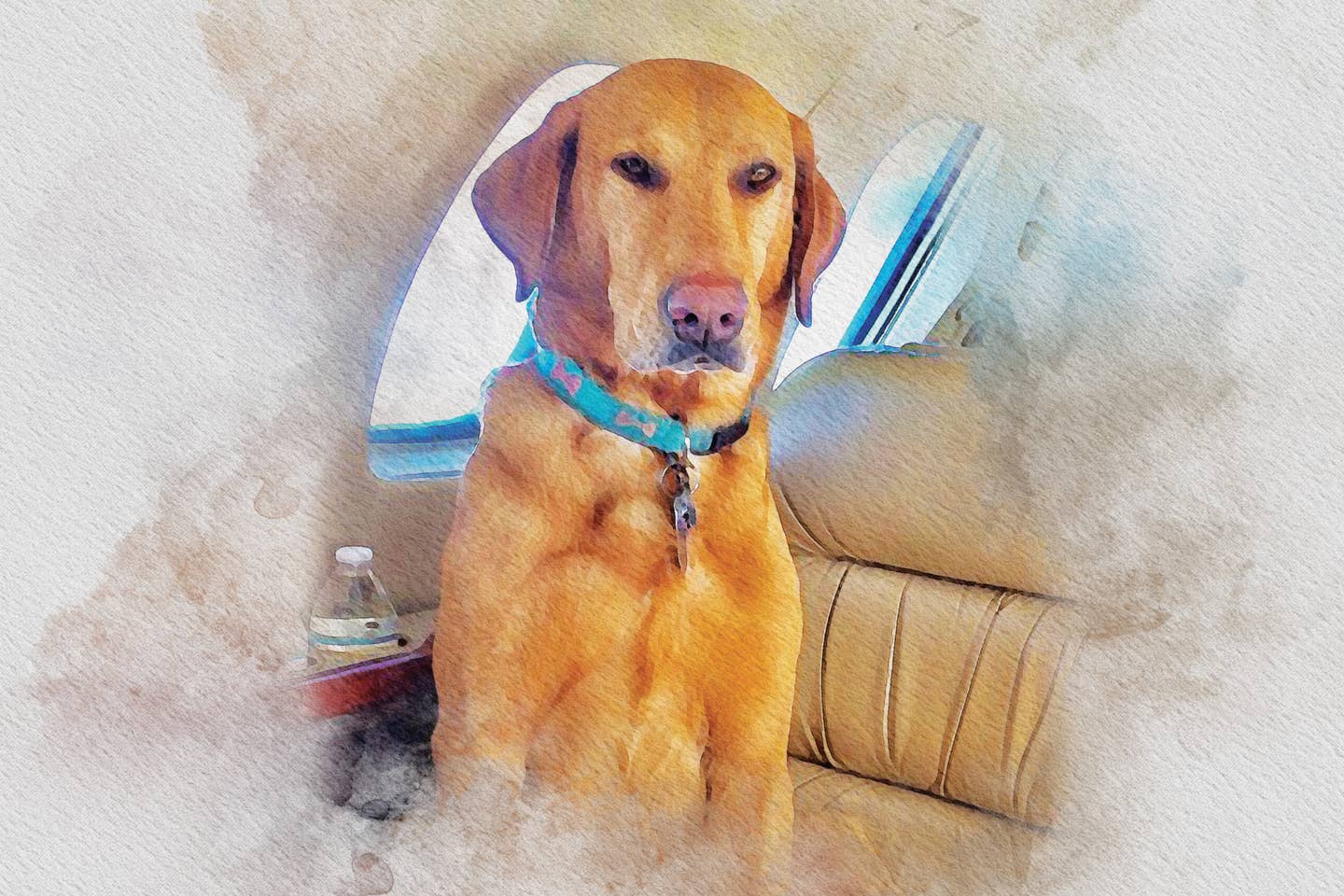Flying for Food: The Butcher Block Edition
Matt Moore’s grandfather Abraham Samuel Dennis was in his early twenties while stationed at Kessler Field in Biloxi, Mississippi, serving as a mess sergeant in the United States Army Air Corps. As the fall season brought about a welcome drop in sticky Southern temperatures, so too came rumors which would soon deploy his unit to a base little known to most Americans. Trace Moore’s culinary roots by flying a Piper Cherokee in search of good butchers and food stories.

In flight snacks are critical to keep the pilot working well. [Andrea Behrends]
As my mother was told, in the fall of 1941, my grandfather Abraham Samuel Dennis was in his early twenties while stationed at Kessler Field in Biloxi, Mississippi, serving as a mess sergeant in the United States Army Air Corps. As the fall season brought about a welcome drop in sticky Southern temperatures, so too came rumors which would soon deploy my grandfather’s unit to a base little known to most Americans.
Its name was Pearl Harbor.
Though the war raged in Europe, the Pacific theater was still an afterthought to most Americans—especially those like my grandfather living stateside. Abraham, or ‘Abie’ as he was known, had rarely traveled outside the family confines of South Georgia. At the time, Pearl Harbor was a dream-worthy outpost, filled with all things étranger: palm trees, rip curls, hula skirts, and pig roasts.
Abie was the son of first-generation immigrants who were born in America, as my great-grandparents had decided to leave the civil unrest in their native Beirut, Lebanon. Like many from that era, our family uprooted their homes in the old country for a new life, opportunity, and freedom.
If you're not already a subscriber, what are you waiting for? Subscribe today to get the issue as soon as it is released in either Print or Digital formats.
Subscribe NowBut we are not always in control of our dreams—or our destiny. In the weeks leading up to deployment, my grandfather was ordered to remain in Mississippi. A few months later, on December 7, 1941, history changed forever. It is a day that lives on in infamy—awakening the sleeping giant of the American war machine.
As the war progressed, my grandfather went on to serve his time at Pearl Harbor. Most of his service remained behind conflict lines, and he largely remained stoic about it. Abe’s younger brother, my great-uncle David, however, was more outspoken and could command an audience with his stories better than anyone I’ve ever known. Even as he reached his final years, his brilliant mind never forsook names or dates, and details were never neglected, despite some slight stretching of the yarn.
My favorite story comes from his time in New Guinea, also serving in the Army Air Corps, where most of his rhythm was spent in foxholes hiding from the Japanese Zeros who would strafe the fields after early morning sorties. When not bombarded by the sky, Lucky Strikes and news from home provided a bit of respite from hell.
One day, an airmail package arrived, light blue 32-ounce Mason jars packed with newspapers and lids pressure sealed. As David relayed, my great-grand- mother Sophie had sent our family pride, fried chicken, across the Pacific, and David and his friends made fast work gnawing down on a taste of home. My cousin Sam, David’s son, is a Valdosta-based attorney who took the effort to depose his own father to ensure our family history preserves such stories, as we lost David during the pandemic of 2020.
Sam and I often laugh and shed tears over bourbons poured neat about the veracity of David’s story, but when you’ve had our family’s fried chicken, it can make you believe in the impossible.
Flying for Meat
On this early spring day, I’m at 7,500 feet in my 1976 Piper Cherokee Cruiser with photographer Andrea Behrends. It’s our first journey for what will become my fifth cookbook, our third together.
While the purr of the Lycoming has served as a soundtrack to most of our travels, Andrea has told me months prior that she is expecting her first child, a baby boy, with her husband Christian. Inevitably, this ‘book writing season,’ as we call it, will certainly be different.
As I pick up the AWOS at Mettel Field (KCEV) outside of Connersville, Indiana, I notice the crosswinds are strong, perfectly perpendicular to Runway 18/36. I give Andrea a quick briefing, letting her know that we’ll go around as needed for safety, casually letting off some of the self-induced pressure by sharing that her baby-in-womb is sneaking in some solid early right-seat time.
Fortunately, the landing is unremarkable, thanks to the forgiving low-wing attributes of the Cherokee, and after tying up the airplane for the evening, we make our way into Cambridge City, Indiana, to meet with butcher Jerry Rihm and the family behind Rihm Foods.
The Next Adventure
Like any pilot, an author is always searching for the next adventure. So, after spending the last decade writing books on all things barbecue (The South’s Best Butts) and grilling (Serial Griller, featured in the May 2020 issue of FLYING), my publisher suggested I com- bine the two subjects into one, something akin to a best-of-hits compilation.
Frankly, I despised the idea altogether, as any true Southerner will tell you that barbecue and grilling are two entirely disparate subjects—e.g. takeoffs and landings.
So, after mulling around for months, I decided to start at the beginning—at a butcher shop—and my own family story.
When my great-grandfather Jim left Beirut, he traversed through France, eventually making the journey through the halls of Ellis Island to settle in south Georgia. Jim’s fruit stand, built from humble beginnings, eventually morphed into a food and gas establishment with living quarters for his family, including my grandfather Abe. They slept on the wooden floors in the back of the building as they persisted through the Great Depression.
Hard work, perseverance, and the formidable American dream served our family well. When Abe and David returned from the war, they built a full-service grocery store with their sister Mary, which became the model of the supermarket to follow.
Abe primarily took up the duties of butchering in house—sides of beef made their way weekly into the store from the Amour Brand food truck that sourced its dry-aged beef from Kansas City. David, a man of many talents, would make sausages on Saturdays and tend to the additional in-store eccentricities, including a hobby shop. On Fridays, Mary would make her relish of mustard, Vidalia onion, and tomatoes to serve on top of hot dogs wrapped in wax paper for those that craved a quick repast.
While I’ve known of such stories, writing this book opened a new opportunity to share our family pride, and recipes like kebabs and kibbe nayyeh, in a time when so many are trying to better understand the source—and the personalities behind the food we consume and enjoy.
As you read this, you are perhaps thinking of that butcher in your family, or the one on the local block where you grew up. So in my new book, Butcher on the Block, we travel from Chinatown in San Francisco to Antibes in the south of France.
Meat, game, seafood, and yes, vegetables, too, are all part of the butchering fabric around the world. And whether grilled, barbecued, raw, roasted, or fried—I aim to track down not only my grandfather’s legacy, but the trade that so lovingly contributes to the nourishment of our communities. Flying often serves as the means by which I can do so.
On the Butcher's Trail
Back to Cambridge City. The Rihm patriarch Jerry is part of a third generation of butcher immigrants who built a local empire in the meat and processing business. Upon arrival, I meet with Jerry’s son Joseph, the next generation, who opens a smoker to unveil a few hog heads smoking on the grate. “Growing up in this family, nothing goes to waste. Besides, these will make great tacos,” says Joseph.
The Rihm family comes together that evening to share a spread honoring their traditions. I’m just glad to be a hungry witness. A ‘County Fair Burger’ made with house-ground pork, jowl bacon, and bar- becue sauce makes me wonder why all burgers are not sourced from pork. Among many a cold beer and Rihm house charcuteries like venison sausage and Braunschweiger, Jerry opines on one dish that’s not in front of my eyes. “Cutting meat, sometimes we save the best pieces for ourselves, like the tail trimmings of strips and ribeyes.
“Most folks don’t want to pay for that extra weight,” he continues, “so we trim it on the line, using our boning knife to cut out the little pearl of meat at the end. After a soak in Worcestershire, we eat that all day with some toasted bread.”
I only have to ask, and Jerry runs back to the shop to give me a taste.
Changing Weight and Balance
As pilots always seeking the next mission, chefs seek the next flavors—and in my journey of writing cookbooks, that change-your-life dish comes at rare and unexpected times. This was the time, and this simple dish of soaked raw beef stops me in my tracks—it’s why I keep flying and writing.
As we depart Cambridge City the following day, Jerry loads me up with a cooler of meats so heavy that I’m forced to recalculate the weight and balance to make sure we are safe for takeoff. I’m especially glad, midflight from Cambridge City to Nashville, to indulge in some venison jerky sticks as an in-flight snack.
Our journeys continue for a year, across the U.S. and the Atlantic, with a newborn that joins the force some- where in middle America. As always, the destinations prove to be worth the journey, and on some occasions, the joy of flying myself to the fun makes good on the ad- age that you can have your steak and eat it too.
Recipe: The Rihm's County Fair Pork Burger
One of Indiana’s best kept secrets is one of the simplest—the pork burger. Frankly, I'm not sure why subbing out beef patties for pork hasn't caught more national attention, but one bite of this delicious, juicy burger will convince any burger purist. The Rihm family makes their patties in house, combining ground pork and their famous jowl bacon to produce a meaty, moist, and smoky base to this classic. I pressed both Joseph and Jerry Rihm as to why it's earned the "county fair" moniker, and both tell me that's because you eat them at the county fair. I can't argue with that! You can dress this burger up as you wish, and it's most often served with either mustard or barbecue sauce—no mayo or ketchup, please.
County Fair Burger
Serves 3
Hands on time: 15 minutes
Total: 45 minutes
1 pound ground pork sausage
1 pound hickory smoked bacon
Kosher salt and fresh cracked pepper
6 slices American cheese
3 large Hawaiian hamburger buns
Barbecue sauce, to serve
6 slices cooked bacon
Thick-sliced sweet yellow onion, to serve
Thick-sliced tomatoes, to serve
Hamburger pickles, to serve
1. Using your hands, combine the sausage and bacon and mix gently until evenly incorporated. Gently create 6 patties, about 1/4 pound each, with your hands, and transfer to a baking sheet. Season each patty liberally on both sides with salt and pepper.
2. Open the bottom vent of a charcoal grill completely. Light a charcoal chimney starter filled with charcoal. When the coals are covered with gray ash, pour them onto the bottom grate of the grill, and then push to one side of the grill. Adjust the vents as needed to maintain an internal temperature of 400° to 450°F. Coat the top grate with oil; place on the grill. (If using a gas grill, preheat to medium high [400° to 450°F] on one side.)
3. Add the burgers over direct heat, and grill for 6 to 8 minutes, keeping the grill covered as needed to avoid flare-ups. Flip the burgers and cook an additional 3 minutes over direct heat. Transfer to indirect heat and continue to cook until the internal temperature reaches 165°F, 4 to 6 more minutes.
4. Place a slice of cheese over each patty, cover the grill, and cook for 45 to 60 seconds, until the cheese is just melted. Remove the patties from the grill and transfer to a clean plate. Quickly toast the buns by grilling them, cut sides down, over direct heat for 1 to 11/2 minutes, until slightly charred.
5. Assemble the burgers by spreading a generous portion of barbecue sauce on the tops and bottoms of the toasted buns. Arrange 2 patties on each bottom bun, and top with 2 slices of bacon. Continue to add additional toppings per your preference and finish with the tops of the buns. Serve.
Excerpt from the book, Butcher on the Block, released on May 9. Available wherever books are sold. Used with permission from Harvest Books, a division of HarperCollins

Subscribe to Our Newsletter
Get the latest FLYING stories delivered directly to your inbox







